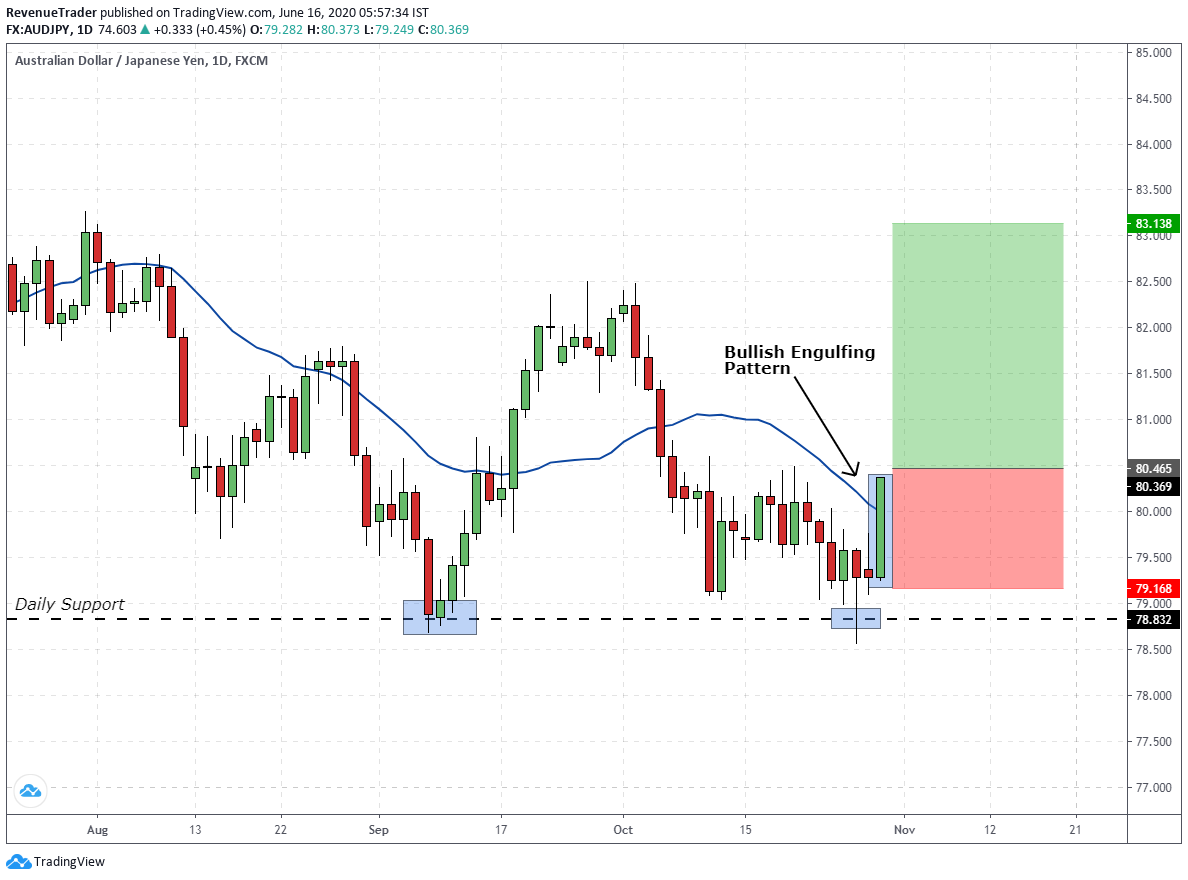In this guide, you’ll learn 3 ways to trade on the daily chart. Mainly we focus on daily time frame forex trading strategy.
Here is the truth, Most forex traders don’t even like to talk about the daily chart. Why is that?
Because trading daily chart is not as exciting as trading lower time frames such as 15-Minutes or 5-Minutes. It is boring and it has fewer trading opportunities.
But did you know that trading on the daily chart will allow you to execute higher profitable trades which often leads to consistent profits? Not only that but also the daily chart helps us to improve areas such as trading psychology, trading discipline and patience.
Read this article about How trading Daily Chart Can Help You Improve Your Trading. on that article, we listed 9 ways trading daily chart help us to become better forex traders.
Today in this article we are going to talk about 3 profitable daily time frame forex trading strategies.
Here are what we are going to talk today.
- How to Trade Trend on the Daily Chart – Trend Trading Strategy
- Support and Resistance Trading Strategy
- RSI Over-Bought and Over-Sold Strategy
Okay, Let’s talk about the first daily time frame forex trading strategy.
How to Trade Trend on the Daily Chart – Trend Trading Strategy
As forex traders, you have probably heard the old saying “Trend is Your Friend“. This is true as long as the trend keeps going up or down.
But the trend is not going forever, at some point it has to reverse and this is where lots of trend traders got caught up.
The point here is, You need to have a set of rule to both identifying on-going trends and trend reversals to trade while minimizing the trading losses.
Okay, Before we talk about trend trading strategy, let’s first talk about how to correctly identifying trends in the forex market.
For this, we are going to use 21-Period EMA and 9-Period EMA.
Here is how to filter out the trending market using these two moving averages.
We use 21-Period EMA to find trend direction – If price trading above the 21-Period EMA, It is a general uptrend and If price trading below the 21-Period EMA, It is a general downtrend.
And,
We use 21-Period EMA and 9-Period EMA to find dynamic support and resistance – During an uptrend, the area between 21-Period EMA and 9-Period EMA work as dynamic support and during a downtrend, the area between two moving average work as a dynamic resistance.
Have look at the AUDJPY uptrend market,

Okay, now you know how to identify trend using moving averages, right?
Related – What is Moving Average in Forex & How to Use It (4 Practical Ways).
Next…
Let’s talk about how to trade trends on the daily chart.
We are going to use price actions as our entry trigger and we are going to talk about how to place stop-loss and take profits correctly.
Let’s dive in…
Have a Look at the EURJPY daily chart.

What have you noticed in the above chart? A downtrend, right?
Price is making lower lows, moving averages are pointing down and above all, the price is bouncing off from dynamic resistance level twice (Have a look at the blue box marked in the chart).
Above factors confirm that we have a healthy downtrend. Now we have to look for a way to go short.
But how? We have to wait for a pullback to dynamic resistance, this is where we have an edge in the downtrend, right?
Now have a look at the chart above. Where is the price right now? At the dynamic resistance, right? This is exactly what we need.
Our next job is to place the trade, for that we need a confirmation to go short. We can use price action for this matter.
Have you noticed any price action pattern here? If you can spot a bearish engulfing pattern, great. This is our entry trigger.
Now all confluences are aligned nicely, Now it is a matter of placing the trade. We can place a sell order here. But where we place stops and targets.
For that have a look at the forex chart below,

According to the above chart, we placed stop-loss a few pips above the lower high, And we used 2R for the target which means our take-profit is twice as the stop-loss.
Beside the stop-loss and take profit, we have to manage the trade, right? This is simple. I called this as “Cutting Losses”.
Basically, I’m moving my stop-loss to breakeven once price hit 1R which is the same distance as the take profit.
Learn more on How to Cut Losses in Forex.
That’s all. This is the end of the first daily time frame forex trading strategy.
Have a look at the two examples that we executed in the last month before move into the next trading strategy.
This is a trend continuation trade on EURUSD that we placed on 20th in June.

And the next trade is on EURJPY. Have a look at the chart below.

Now let’s move onto the second daily time frame forex trading strategy – Support and resistance trading strategy.
Support and Resistance Trading Strategy in the Daily Chart
Support and resistance are one of the highly rated and most profitable trading tools when it comes to anticipating market movements. Almost every trading strategies out there use some sort of support and resistance.
Another fact about support and resistance is that they tend to works better on higher time frames especially in the daily chart.
But to get maximum out of support and resistance, they have to fulfil one trading rule.
It should be near term support or resistance.
Which mean price has to be test support or resistance in the near past. Have look at the 4-Hour gold chart below.

According to the above chart, you can see that there is a level comes from the daily chart which acts as a resistance in past.
But on the 4-hour we can see that price again bounce from that daily resistance level and this confirms this resistance is valid and can look for trades in future.
Just like that before looking for any trades we have to confirm the validity of the support and resistance.
Now let’s see how to trade support and resistance on the daily chart.
After identifying support or resistance our next job is to wait for confirmation, right?
So what are the confirmations that we can use to find the price movement around support or resistance?
This is where Engulfing Candlestick pattern and pin bar comes in.
Have a look at the Bullish engulfing pattern occurred on AUDJPY Daily chart,

Have a look at the marked bullish engulfing candlestick pattern in the above chart. Why this candle is important for us?
There are two reasons, one is Bullish engulfing pattern indicate buying pressure and the second one is it occurred at daily support level which is a higher probability area to look for trade opportunities.
With all these confluences in mind, we place stop-loss few pips below the bullish engulfing pattern and we use 2R for the take profit.
Have a look at the chart below for the final results.

Just like that, you can also use the pin bar as your entry technique. Have a look at the chart below,

Now…
It is time for the last daily time frame forex trading strategy.
RSI Over-Bought and Over-Sold Trading Strategy
So what is RSI (Relative Strength Index)?
RSI is a momentum oscillator that measures the strength and momentum of price movements.
Read our Ultimate Guide to the RSI indicator to learn more about the RSI Indicator.
Now let’s see how to use RSI over-bought and over-sold as an effective trading signal to go long and short.
Before that keep in mind RSI over-bought and over-sold is not trading signals, But if you can combining RSI over-bought and over-sold with price actions, then you can have a small edge over the market.
Have a look at the chart below, first, you can see that price fell after the RSI overbought signal and the same thing happened again after the RSI over-sold signal – price move higher.

Now the question is how to catch these movements? The breakout strategy comes very handily in this kind of scenarios.
Have a look at the AUDJPY daily chart below.

Note how RSI over-bought and break of the local structure level aligned.
Why we wait for a breakout? By waiting for the breakout we can increase the probability of our trade.
Remember that more confluence means higher probability.
According to the above chart first, we wait for RSI over-bought signal then we wait for local structure level to be broken to the downside. Now all we have to do is place our orders, right?
Have a look at the chart below to understand how we enter and place stop and take profits.

As the above chart showed we placed sell orders after the breakout and placed stop-loss few pips above the moving average. We use 2R for the take profit.
Okay… there you have it. 3 Profitable daily time frame forex trading strategies.
Next, I have a question for you. If you like any of these trading strategies, How you are going to interpret these strategies to your trading career?
Just head over to any currency pair and going to trade these strategies, is that what you are going to do?
Then stop reading this article!
If you like any of these strategies, I highly recommend you go over a few historical chart check whether these trading strategies are going to work or not. Also, make sure to check whether these strategies are suits for your personality or not.
Personality check is very important. Why? Because you cannot profit from any trading strategy which is not suited for your personality.
Just like that successful forex trading involve unique sets of skills, and anyone can develop that skill. All you have to learn is how profitable traders THINK and what sets them apart from the rest.
Reality is everyone wants to learn the secrets of highly profitable traders, right?
But, What are those secrets?
Well, there is no secret. If you have any kind of experience in the forex market you’ll know that there is no secret.
But there is a huge gap separating the successful traders from the losing traders.
That gap is called Thinking.
Yeah, Successful trader’s thinking process is different from new traders.
Yuan Byeajee – A successful trader – has an article on The Thinking Process of Highly Profitable Traders. Read this article to learn more about how successful traders think.
Also, consider reading the Trading in the Zone by Mark Douglas. This is a good and must-read trading book for any trader.
So what is your favourite trading strategy? Let me know in the comment section.







